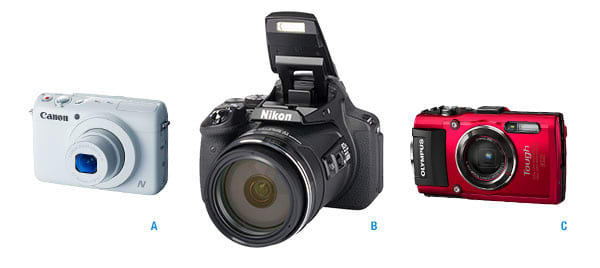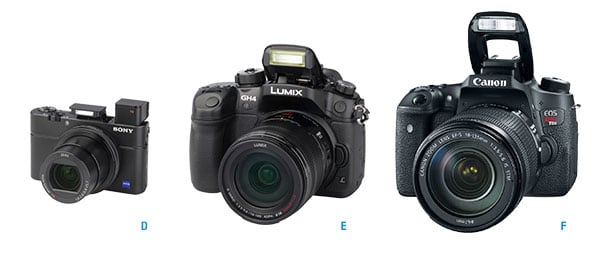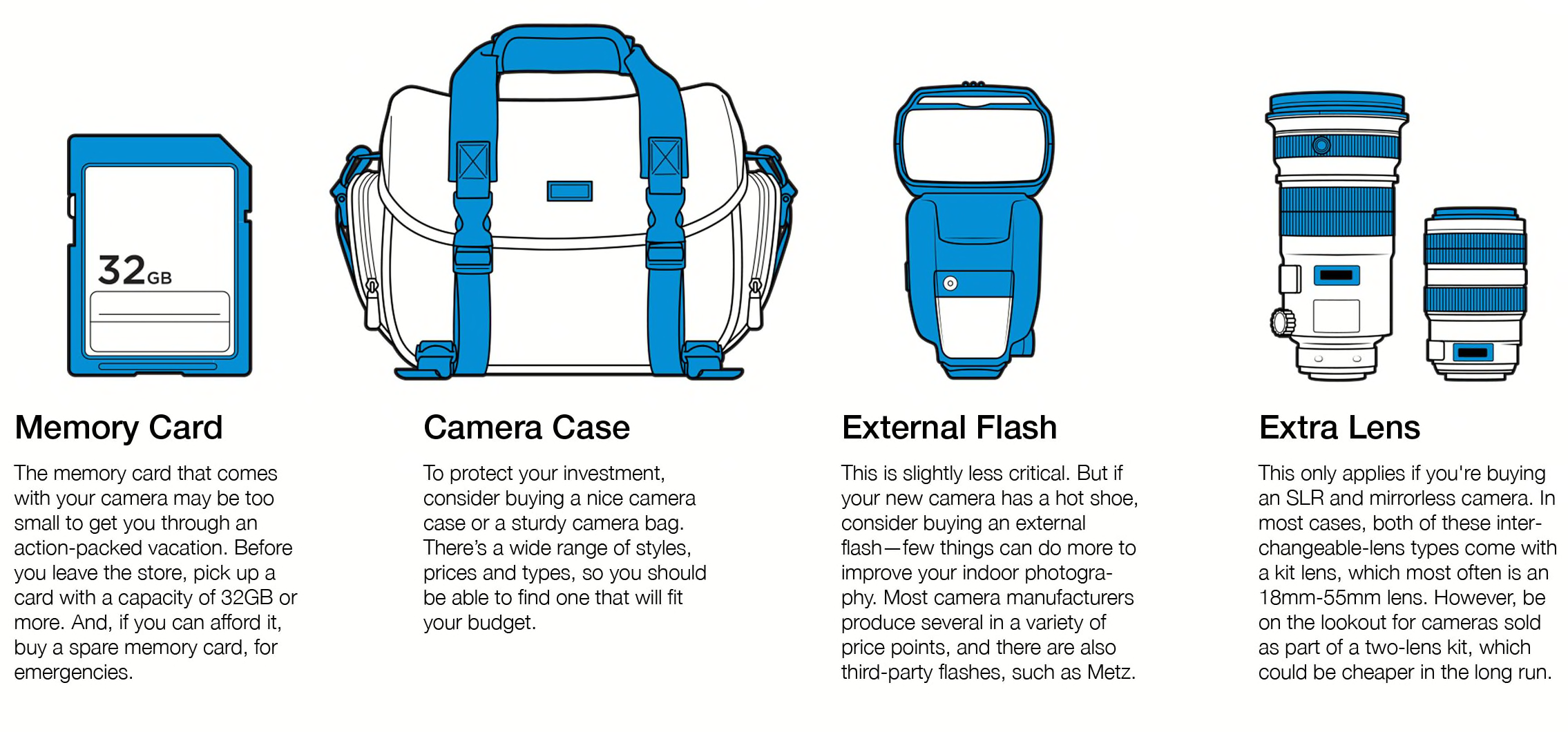If you’re just getting started, the first decision is whether to choose a basic camera or an advanced one. Here’s the difference: If you plan to just point the camera and shoot, you need (you guessed it) some sort of point-and-shoot. If you sometimes want to fiddle with exposure settings or even swap out lenses, you should look at advanced cameras.
Once you make that first decision, it’s time to get a bit more detailed. One of following six camera types—three basic and three advanced—will be right for you.
After reading this post checkout the Cameras offered on my Website
6 Camera Categories
There are three kinds of basic cameras and three kinds of advanced cameras. Here’s what they cost and what they can do. (Narrow your choice down to one or two types and shopping becomes much easier.)

Basic Cameras
Basic point-and-shoot cameras are used pretty much the way you shoot photos with a smartphone. Simply set the camera to either a fully auto mode or a scene mode, and fire away. You have only coarse control over exposure settings, and you can’t switch lenses. But point-and-shoots do vary quite a bit in terms of features and capabilities. At Consumer Reports, we recognize three flavors of basic camera.
A. Basic point-and-shoots (price range: $90 to $270). These are simple, portable cameras, but some have optical zoom ranges as long as 23x. That’s fine for shooting anything in your backyard but probably not enough to capture action from across a soccer field. Some of these cameras have touch screens. And almost all are lightweight and slim, which make them ideal for slipping into your pocket or bag.
B. Superzoom point-and-shoots (price range: $180 to $600). If you go to a lot of baseball games or concerts, you may want a superzoom camera. These models have optical zooms of at least 24x, and some are as long as 83x. That can literally capture craters on the moon. Many superzooms have nice grips, which can help you stabilize your camera when you shoot. Current models are also more compact and lighter than their predecessors.
C. Waterproof point-and-shoots (price range: $110 to $390). If you want to shoot photos or video at the bottom of a swimming pool or beneath the waves, consider a waterproof point-and-shoot. Note that capabilities vary: Some cameras in this category are claimed to be waterproof to 50 feet, and others can be submerged to a fraction of that depth. With strengthened inner and outer chassis construction, most of these cameras are also rugged enough to survive a fall of several feet and to function properly in colder temperatures.

Advanced Cameras
If a camera gives you fine control over exposure settings, we group it with advanced models. But that’s just one of the elements that sets these cameras apart. They all have large image sensors and other features to help produce high-quality images.
D. Advanced point-and-shoots (price range: $250 to $3,300). Like basic point-and-shoots, they have nondetachable lenses, but they also have manual controls and other advanced features. They’re also more expensive than basic point-and-shoots. Most have hot-shoe mounts for an external flash and can produce RAW files—the best format to use with image-editing software. Some have high-quality electronic viewfinders—helpful if you shoot in bright light and the LCD looks washed out.
E. Mirrorless models (price range: $440 to $4,000). These models accept interchangeable lenses, like SLRs, but they’re smaller and lighter. Downside: They don’t have an SLR through-the-lens viewfinder. Mirrorless cameras have large sensors for enhanced images. Some expensive models have full-frame sensors; these are the size of a frame of 35-mm film and enhance low-light performance. Mirrorless models can also capture RAW files.
F. SLRs (price range: $400 to $3,300). SLRs are interchangeable-lens cameras, and most are compatible with a number of lenses. With the most features, they’re also the biggest and heaviest. All SLRs have large sensors for enhanced image quality in low light. They also have through-the-lens viewfinders, which use mirrors to display the photo subject exactly as it appears through the lens. As with mirrorless cameras, there are some pricey SLRs that include full-frame sensors. SLRs can also capture RAW files.
Specs That Matter
Once you have a general idea of what type of camera you’d like to get and how much you want to spend, you can dive deeper into the specs. Just remember that no single spec or feature can tell you whether a camera is good or not.
Megapixel counts, in particular, can almost be ignored these days—even though they get mentioned prominently in ads and by salespeople. The number tells you how fine the resolution the final picture will have, but every camera on the market has enough megapixels for most people. You only need more than 16 megapixels if you want to send out for literally poster-sized prints of your photos.
So, if megapixels don’t matter much, what should you look for? Here are some important features to consider:
Sensor Size
When you hear “sensor,” think “film.” This is the component inside a digital camera that captures the image. And the larger the sensor, the better the performance will tend to be, particularly in low light. Some pricey models even include a full-frame sensor, the largest sensor available on consumer models. Unfortunately, there isn’t a uniform standard of measurement. For instance, large sensors include 1-inch sensors and 35-mm full-frame sensors, which, as you can see, are measured differently. However, if you’re interested in quality, get the largest sensor size you can. You can often find this information on a camera’s product page on the manufacturer’s website. Also, you can research the phrase “camera sensor sizes” online to find charts that show the comparative sizes of image sensors. In general, most cameras that include a sensor that’s 1 inch (12.8×9.6 mm) or larger can be considered an advanced camera.
Try Out Cameras in a Store
Before you buy, we suggest trying out a camera model in a walk-in store so that you get a sense of how the camera feels in your hand.
Check the size and weight. No matter what type of photographer you are, you’ll want to consider a camera’s size as well as other factors when choosing a model. Do you want something portable for traveling, like a small, compact point-and-shoot (below, left)? Or are you okay with a big and bulky model, like a large superzoom (below, right)? Remember, if you’re traveling and you’re camera is heavy, you may take fewer photos and miss important moments.
Consider the controls. What do the buttons, switches, dials, and levers look like on your camera? Do you like these types of controls? Most cameras have just a few, and you’ll need to change most of the settings in the menu system, which is why a touch-screen LCD can be useful. SLRs have the most physical controls, which makes changing the settings quick and easy.
What Else to Shop For
There are various accessories, from essential to esoteric, that you can get for your camera. And depending on which model you buy, some can be pretty pricey. For most, you’ll want to consider the following accessories when you purchase a camera:

Canon offers an extensive line of models in every category. Its compact PowerShots line includes several different series, including point-and-shoots (ELPH series), superzoom (SX), rugged (D), and advanced point-and-shoots (S and G). The EOS Rebel series helped to define budget SLRs. Other SLRs include a host of pro and more advanced consumer models, including models that have large, full-frame sensors. Canon also offers a broader selection of lenses than most brands. Canon also sells a line of EOS M-series and R-series mirrorless models and compatible lenses.




